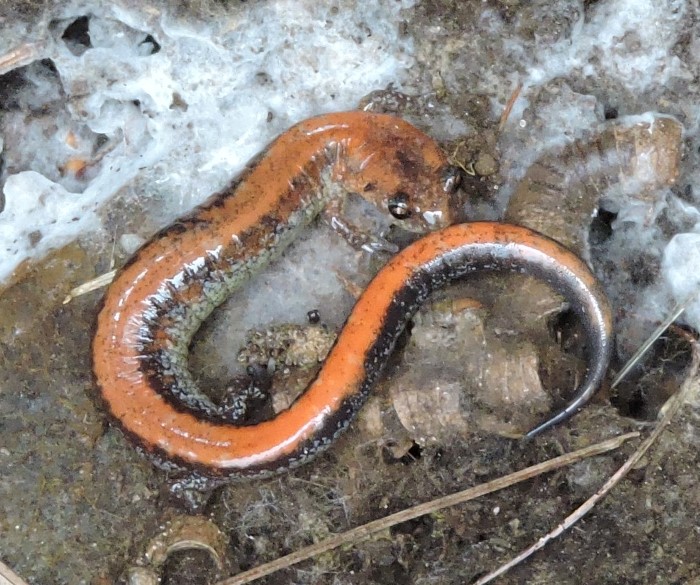
We try to keep an ever-watchful eye peeled for wildlife at the cottage, whether looking skyward for hawks; gazing out over the water for loons and mergansers; examining roadside foliage for camouflaged deer; or, patiently watching for butterflies to alight on flowers in the garden. Sometimes, however, our minds are simply focused on a job at hand and we can be startled by the sudden appearance of an unexpected beastie.
This has happened to us several times when an unexpected movement at our feet or a flash of colour appears as we dig about in the garden, under the cottage, or by the boathouse. What we have encountered are snakes and salamanders.
Our common refrain, “What is that … a snake?” was proven wrong the day we were tidying discarded wood around the base of the boathouse. The beastie was not a snake; it was long and slender like a snake but it also had four legs and so was a salamander … a blue-spotted salamander which is generally found in moist habitats including organic litter in deciduous, coniferous or mixed forests, as well as swamps, and under boathouses at the cottage. Typically, these salamanders spend their lives on the forest floor, often living underground in burrows. They breed in permanent swamps or temporary ponds, marshes or even roadside ditches, and over winter underground in plant matter in the forest.

Another salamander we have seen at White Lake is the eastern red-backed salamander which is also commonly found in deciduous or mixed forests as well as in cool, moist white pine forests. It prefers woodlands with lots of fallen logs and leaf litter.

In 2015 for the first time, we uncovered a yellow-spotted salamander while moving wood under the cottage. It was startling in its beauty. The yellow-spotted salamander is often simply called the spotted salamander but to keep it straight from the blue-spotted one, we always refer to it as the yellow-spotted salamander. It has large yellow or orange spots and we understand it can grow to well over 20 centimetres in length. Like our other salamanders, the yellow-spotted salamander can be found in deciduous or mixed forests and around ponds.

Each time we have discovered a salamander at White Lake, we have at first thought it was a snake. Sometimes what startles us is a snake. In addition to not having legs, snakes have scales rather than the salamander’s smooth skin. We probably have several species of snake at the cottage, at least the books suggest we could, but we have only seen and photographed northern water snakes, eastern garter snakes, and red-backed snakes.
The snake we see most frequently at the cottage is the northern water snake which can be found in and around our shoreline which is largely bordered by reeds. It is found in almost all permanent bodies of fresh water in Ontario, including lakes, rivers and wetlands. They can also be found basking on rocks and logs, or in other open habitats along the edges of the water or under rocks along the shoreline. We do not bother them and they do not bother us. They are not venomous and only bite in self-defence.

Our favourite snake, from our childhood, is the eastern garter snake which is a habitat generalist. It can be found in a wide variety of habitats, including forests, wetlands, fields and rocky areas. We see it only occasionally, not nearly as often as we would like.

Our third snake is the red-backed snake, but unfortunately, we have only ever seen them squashed on the road … sigh … so we will not include it here, other than to acknowledge its presence at White Lake.
An excellent source of information about salamanders and snakes is the ROM Field Guide to Amphibians and Reptiles of Ontario. We also like www.ontarionature.org.

